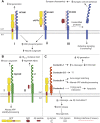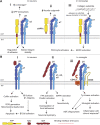Amyloid precursor protein (APP) and amyloid β (Aβ) interact with cell adhesion molecules: Implications in Alzheimer's disease and normal physiology
- PMID: 35959488
- PMCID: PMC9360506
- DOI: 10.3389/fcell.2022.969547
Amyloid precursor protein (APP) and amyloid β (Aβ) interact with cell adhesion molecules: Implications in Alzheimer's disease and normal physiology
Abstract
Alzheimer's disease (AD) is an incurable neurodegenerative disorder in which dysfunction and loss of synapses and neurons lead to cognitive impairment and death. Accumulation and aggregation of neurotoxic amyloid-β (Aβ) peptides generated via amyloidogenic processing of amyloid precursor protein (APP) is considered to play a central role in the disease etiology. APP interacts with cell adhesion molecules, which influence the normal physiological functions of APP, its amyloidogenic and non-amyloidogenic processing, and formation of Aβ aggregates. These cell surface glycoproteins also mediate attachment of Aβ to the neuronal cell surface and induce intracellular signaling contributing to Aβ toxicity. In this review, we discuss the current knowledge surrounding the interactions of cell adhesion molecules with APP and Aβ and analyze the evidence of the critical role these proteins play in regulating the processing and physiological function of APP as well as Aβ toxicity. This is a necessary piece of the complex AD puzzle, which we should understand in order to develop safe and effective therapeutic interventions for AD.
Keywords: Alzheimer’s disease; amyloid precursor protein (APP); amyloid-beta; cell adhesion molecule (CAM); immunoglobulin superfamily; integrin; neurexin; prion protein (PrP).
Copyright © 2022 Pfundstein, Nikonenko and Sytnyk.
Conflict of interest statement
The authors declare that the research was conducted in the absence of any commercial or financial relationships that could be construed as a potential conflict of interest.
Figures







Similar articles
-
Alzheimer's disease.Subcell Biochem. 2012;65:329-52. doi: 10.1007/978-94-007-5416-4_14. Subcell Biochem. 2012. PMID: 23225010 Review.
-
SNX27 and SORLA Interact to Reduce Amyloidogenic Subcellular Distribution and Processing of Amyloid Precursor Protein.J Neurosci. 2016 Jul 27;36(30):7996-8011. doi: 10.1523/JNEUROSCI.0206-16.2016. J Neurosci. 2016. PMID: 27466343 Free PMC article.
-
Beta-amyloid, neuronal death and Alzheimer's disease.Curr Mol Med. 2001 Dec;1(6):733-7. doi: 10.2174/1566524013363177. Curr Mol Med. 2001. PMID: 11899259 Review.
-
[Alzheimer disease: cellular and molecular aspects].Bull Mem Acad R Med Belg. 2005;160(10-12):445-9; discussion 450-1. Bull Mem Acad R Med Belg. 2005. PMID: 16768248 French.
-
Roles of amyloid precursor protein and its fragments in regulating neural activity, plasticity and memory.Prog Neurobiol. 2003 May;70(1):1-32. doi: 10.1016/s0301-0082(03)00089-3. Prog Neurobiol. 2003. PMID: 12927332 Review.
Cited by
-
Mitochondrial Complex I and β-Amyloid Peptide Interplay in Alzheimer's Disease: A Critical Review of New and Old Little Regarded Findings.Int J Mol Sci. 2023 Nov 3;24(21):15951. doi: 10.3390/ijms242115951. Int J Mol Sci. 2023. PMID: 37958934 Free PMC article. Review.
-
Current Insights of Nanocarrier-Mediated Gene Therapeutics to Treat Potential Impairment of Amyloid Beta Protein and Tau Protein in Alzheimer's Disease.Mol Neurobiol. 2024 Apr;61(4):1969-1989. doi: 10.1007/s12035-023-03671-7. Epub 2023 Oct 13. Mol Neurobiol. 2024. PMID: 37831361 Review.
-
Let-7 Family as a Mediator of Exercise on Alzheimer's Disease.Cell Mol Neurobiol. 2025 May 19;45(1):43. doi: 10.1007/s10571-025-01559-9. Cell Mol Neurobiol. 2025. PMID: 40389769 Free PMC article. Review.
-
The tau isoform 1N4R confers vulnerability of MAPT knockout human iPSC-derived neurons to amyloid beta and phosphorylated tau-induced neuronal dysfunction.Alzheimers Dement. 2025 May;21(5):e14403. doi: 10.1002/alz.14403. Epub 2025 Feb 28. Alzheimers Dement. 2025. PMID: 40019008 Free PMC article.
-
Perinatal Tissue-Derived Stem Cells: An Emerging Therapeutic Strategy for Challenging Neurodegenerative Diseases.Int J Mol Sci. 2024 Jan 12;25(2):976. doi: 10.3390/ijms25020976. Int J Mol Sci. 2024. PMID: 38256050 Free PMC article. Review.
References
-
- Alzheimer’s Association (2022). 2022 Alzheimer's disease facts and figures. Alzheimer's Dementia 18, 700–789. - PubMed
Publication types
LinkOut - more resources
Full Text Sources
Research Materials

